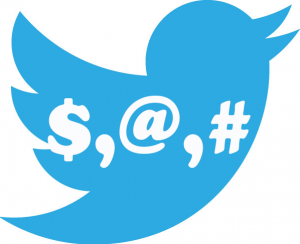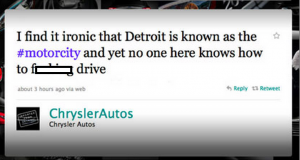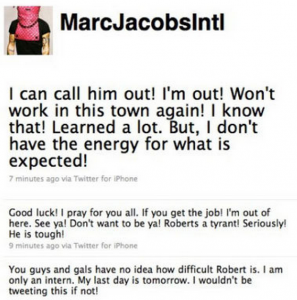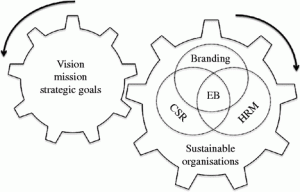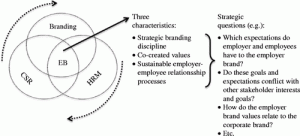If you’ve read all the articles which explain the ways to create a good social campaign and you’re still not reaching the success you had expected, then maybe you’re making some fatal errors. Highlighted accordingly are some of the worst mistakes that companies have made when trying to get noticed on twitter.
Current assessments of branding define branding as the revealing and broadcasting of brand intentions, internally (Punjaisri and Wilson, 2007) or externally (Ewing et. al., 2002);
“Every second, the thoughts and feelings of millions of people across the world are recorded in the form of 140-character tweets using Twitter” (Mislove, A. et al, 2011).
Source: Twitter (2015)
Twitter is useful way for organisations to connect with an audience and share opinions and material that is widely viewed. The messages are limited to 140 characters and therefore the messages should be clear, concise and significant. Twitter is a great way to communicate, however is you aren’t utilising social media in the correct way then you could communicate negatively.
“The optimists celebrate social media and predict that it will cause more participation and democratization. The cynics, in contrast, condemn social media as shallow and arbitrary, while equating the death of meaningful communication and intimacy with social media’s mass proliferation” (Murthy, D. 2013)
Avoid Foul and abusive language
‘Chrysler’ had a mishap when there twitter account was used in a distasteful way. The company used inappropriate language in a tweet, the damaging tweet was as follows…
Source: Chrysler Twitter. (2011). Twitter feed.
This type of language is certainly unacceptable for a professional organisation and can be detrimental to a reputation. The organisation later deleted the tweet and apologised and dismissed the employee from the company, making it clear that the tweet was unacceptable in their opinion. Chrysler’s statement was as follows:
“Chrysler Group and its brands do not tolerate inappropriate language or behaviour, and apologize to anyone who may have been offended by this communication.” Chrysler Twitter. (2011). Twitter feed.
A crucial notion in brand management is the concept of ‘brand identity’, presented by Aaker (1996) and Kapferer (1997), and consists of ideas like ‘brand essence’ (Aaker and Joachimstahler, 2000), ‘core identity’ (Aaker, 1996), or even the ‘brand DNA’ (Kapferer, 1997). Chrysler may need to establish better brand management to ensure that this type of mishap doesn’t threaten their reputation again in the future. Chrysler should create tweets which convey the brand essence they are striving for, this will better establish their core identity in the market and the brand DNA will be noticeable in there exertion.
Avoid insensitive use of a hashtag
UK home furnishings retailer ‘Habitat’ is now apologising for its inappropriate hashtags. The twitter page – @HabitatUK, was found to be using public trends in order to gain more attention on the social media outlet. Habitat’s hashtags were related to the negative circumstances in Iran to enhance their own traffic…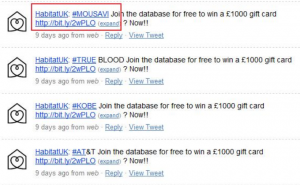 Source: Inquisitr. (2009). Habitat UK’s Twitter fail.
Source: Inquisitr. (2009). Habitat UK’s Twitter fail.
Habitat apologised following the incident, explaining…
“Top ten trending topics were posted into hashtags without checking with us and apparently without verifying what all of the tags referred to… its valuable to hear how users would like us to use Twitter and we are determined to do better for the Twitter community.” @HabitatUK (2009)
Brand management can be defined by the supervision of ‘brand identity’ and the developing of ‘brand benefits’ in relation to stakeholders (McCracken, 1993; Sherry, 2005). Habitat may have threatened their brand prestige and could’ve endangered the trust that customers have with the company. It’s important for the company to learn from their mistakes and they should show the public that they’re honourable by trying to gain their trust in future campaigns. Another example of an insensitive use of a hashtag was when Bing had to apologise for #SupportJapan stunt following a negative Twitter reaction, the organisation offered to donate $1 for every retweet.
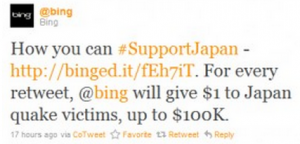
Source: Keogh. S. (2011). Bing says sorry for #SupportJapan stunt following Twitter backlash.
Although this charitable act may have been made with good intentions, the audience were questioning the intents of the organisation. The true purpose of the tweet could have been the marketing elements, therefore ‘Bing’ could have using a devastation for own lucrative benefit. Some celebrities such as Ryan Seacrest did retweet it, this means it would’ve then been on display to his 4 million followers at the time, and so Bing really were noticed. However, it’s important to remember that not all publicity has a positive outcome and the reaction of the hashtag was the #f***bing hashtag, along with many angry comments. This response hashtag can be referred to as a ‘bash-tag’, this is a hashtag which tries to humiliate the original hashtag.
Source: Keogh. S. (2011). Bing says sorry for #SupportJapan stunt following Twitter backlash.
US comedian Michael Ian Black, tweeted a reaction to his 1.6m followers:
‘Hey @bing, stop using a tragedy as a f***ing marketing opportunity.’
Bing later apologised and offered $100,000 to the charity in order to show there genuine support for the cause.
Avoid administering your twitter account with an untrustworthy representative
Marc Jacobs’ was on the hunt for a new Twitter pundit, the original spokesperson CEO Robert Duffy was swapped for an intern. The intern was given the responsibility of updating the brand’s 114,000 followers at @marcjacobsintl. He was struggling to adapt to the new occupation and felt like the company placed too much pressure upon him. The intern vented his anger on the company twitter page. He called Mr Duffy a ‘tyrant’ and thought he was ‘praying’ for his replacement.
Soure: @marcjacobsintl(2011).
Marc Jacobs twitter was updated in order to apologise for the stunt and advise the readers
“Protect your passwords.” @marcjacobsintl(2011).
The company then offered the fired employees job to the public in jest…
Source:Madison. J. (2011). Marc Jacobs intern brands company CEO a ‘tyrant’ in meltdown on fashion label’s Twitter account.
Using trustworthy employees to manage a twitter account is a valuable lesson and should be remembered by all organisations to avoid such public perception into a company. In this case the public were given insight was the unsatisfactory working atmosphere that the intern experienced, this could create a negative reputation for the organisation. Ambler and Barrow (1996) recognise that it’s incredibly important for brand management to be implemented into organisations in order to gain a better reputation from a customer’s perspective. Another example of administering a twitter account with an undependable representative is when VodafoneUK’s representative sent out a tweet which was offensive. VodafoneUK’s homophobic message could potentially have reached there 8,824 followers and more as users of the facility kept a copy of it and were therefore able to share it. VodafoneUK expressed
“We weren’t hacked. A severe breach of rules by staff in our building, dealing with that internally. We’re very sorry” VodaphoneUK (2010).
Avoid an unsuitable hashtag
McDonald’s proposed a Twitter campaign and paid for the honour of having their hashtag indorsed on the Twitter homepage. Using the hashtag #McDStories; it was expecting gratifying tales about their organisation.
Source: Roberts, H. (2012). #McFail! McDonalds’ Twitter promotion backfires as users hijack #McDstories hashtag to share fast food horror stories.
However, it enticed insults about the chain of fast food and McDonald’s critics used the outlet to share their #McDHorrorStories.Examples of the reaction tweets are as follows:
“#McDStories isn’t going the direction I think @mcdonalds wanted it to go. Lots of weed stories and heart attack jokes”. (via twitter)
“Ate a McFish and vomited 1 hour later….The last time I got McDonalds was seriously 18 years ago in college… #McDstories” (via Twitter)
It’s reported that that they cancelled the campaign within two hours. Rick Wion, McDonald’s social media director offered the following statement…
“As Twitter continues to evolve its platform and engagement opportunities, we’re learning from our experiences,”
Here’s a YouTube video explaining some more tweets which were part of the uproar
Source: Mashable (Youtube). (2012). McDonalds’ Promoted Hashtag Backfires, Goes Viral.
So the lesson to be learned is to target the market with a hashtag which is suitable for your organisation. McDonalds have since used a hashtag #meetthefarmers, which has proven to be more beneficial for the organisations as it gives consumers an opportunity to find out about the ingredients used in the fast food chain restaurant. Therefore you should always implement awareness and knowledge of your brands status, if you misread your organisations reputation you could risk a mishap like McDonald’s. The reaction hashtags which poke fun as the original posts can be referred to as ‘bash-tag’, another example of this was when Blackberry tried to gain interest in the #BeBold campaign.
Blackberry were part of an unsuitable hashtag marketing fail as Jackson, E. (2012) reports in the article ‘BlackBerry-maker torched by blowback on RIM superhero blog’. The company ‘Research in Motion’ (RIM) worked in conjunction with blackberry to create superhero cartoons which asked the audience to make there year (2012) “A Better, Bolder 2012”. The idea was established through 35,000 replies to RIM’s #BeBold Twitter hashtag for New Year’s resolutions. RIM (2012) commented that the marketing campaign was “intended to be a bit of fun”. Nonetheless twitter users poked fun at the childish cartoons which didn’t properly target the adult audience that they should have been addressing.
The following youtube video offer tips about how to avoid being the brunt of a joke. Overall it’s clear that brands should evaluate how susceptible they are when determining the success of their marketing campaigns.
Source: Likeable Media (Youtube). (2012). How You Can Deal With Bashtags On Twitter.
Do Implement Brand management
Branding and brand management is not just about communicating values; it’s progressed into a practise of ‘value creation’, a planned resource (Balmer and Greyser, 2002; Hatch and Schultz, 2003).
Figure 1: Employer branding processes in sustainable organizations (Kryger, H. et al. 2011).
The model proposed by Kryger, H. et al. (2011), illustrates that if employer branding is going to succeed in a sustainable organisation then it must be at the centre. Success can be achieved through combining the employer branding (EB) process with the Corporate Social Responsibility (CSR) and Human resource management (HRM) aspects. These need to work in conjunction with the organisations vision, mission and strategic goals for the best chance of success. It’s essential that organisations reflect upon their own role in society, its ‘corporate context’ and its ‘relation to the individual employee’ (Figure 1).
Figure 2: Employer branding processes in sustainable organisations: characteristics and reflections (Kryger, H. et al. 2011).
The Figure 2 model suggests that for EB, CSR and HRM to work collectively then it may be valuable to welcome stakeholders to discuss and co‐create the brand and highlight the developments of value creation. Moving from a ‘product‐oriented’ viewpoint to a ‘process‐oriented’ viewpoint, foundations such as “dialogue, trust and transparency” are vital to guarantee “strategic, sustainable relationships” (Kryger, H. et al. 2011).
References
- Aaker, D.A (1991), Managing Brand Equity: Capitalizing on the Value of a Brand Name, Free Press: NY. Aaker, D.A. (1996), Building Strong Brands, Free Press: NY.
- Aaker, D.A. and Joachimstahler, E. (2000), Brand Leadership, Free Press: NY.
- Ambler .T and Barrow Simon (1996): Employer Branding ,Journal Of Brand Management, 4(3),pp184
- Balmer, J.M.T. and Greyser, S.A. (2002), “Managing the multiple identities of the corporation”, California Management Review, Vol. 44, No. 3, 72-86.
- Chrysler Twitter. (2011). Twitter feed. Available: https://twitter.com/chrysler. Last accessed 07/04/15
- Ewing, M.T., Pitt, L.F., de Bussy, N.M. and Berthon, P. (2002), “Employment branding in the knowledge economy”, International Journal of Advertising, Vol. 21, 3-22.
- Hatch, M.J. and Schultz, M. (2003), “Bringing the Corporation into Corporate Branding”, European Journal of Marketing, Vol. 37, No. 7-8, 1041-1064.
- Inquisitr (2009). Habitat UK’s Twitter fail. Available: http://www.inquisitr.com/27226/habitat-uks-twitter-fail/. Last accessed 07/04/15.
- Jackson, E. (2012). BlackBerry-maker torched by blowback on RIM superhero blog.Available: http://www.thestar.com/business/2012/01/31/blackberrymaker_torched_by_blowback_on_rim_superhero_blog.html. Last accessed 08/04/15.
- Kryger, H. Sophie, A. Andersen, E. Christa Thomsen, C.(2011),”Conceptualising employer branding in sustainable organisations”, Corporate Communications: An International Journal, Vol. 16 Iss 2 pp. 105 – 123Kapferer, J. N. (1997), The Strategic Brand Management, Kogan Page: London.
- Keogh. S. (2011). Bing says sorry for #SupportJapan stunt following Twitter backlash. Available: http://wallblog.co.uk/2011/03/13/bing-says-sorry-for-supportjapan-stunt-following-twitter-backlash/. Last accessed 07/04/15.
- Madison. J. (2011). Marc Jacobs intern brands company CEO a ‘tyrant’ in meltdown on fashion label’s Twitter account. Available: http://wallblog.co.uk/2011/03/13/bing-says-sorry-for-supportjapan-stunt-following-twitter-backlash/. Last accessed 07/04/15.
- McCracken, G. (1993), “The Value of the Brand: an anthropological perspective”, in: Aaker, D.A. and Biel, A.L., (eds.), Brand Equity and Advertising, Lawrence Erlbaum Associates: Hillsdale, NJ, 125139.
- Mislove, A., Lehmann, S., Ahn, Y. Y., Onnela, J. P., & Rosenquist, J. N. (2011). Understanding the Demographics of Twitter Users. ICWSM, 11, 5th.
- Murthy, D. (2013) Twitter: Social Communication in the Twitter Age, Cambridge, UK: Polity Press
- Nudd. T. (2011). Chrysler throws down an F-bomb on Twitter . Available: http://www.adweek.com/adfreak/chrysler-throws-down-f-bomb-twitter-126967. Last accessed 07/14/15.
- Punjaisri, K. and Wilson, A. (2007), “The role of internal branding in the delivery of employee brand promise”, Brand Management, Vol. 15, No. 1, 57-70. Prahalad, C.K. and Ramaswamy, V. (2004), “Co-creation experiences: The next practise in value creation”, Journal of Interactive Marketing, Summer, 18 (3), 5-14.
- Roberts, H. (2012). #McFail! McDonalds’ Twitter promotion backfires as users hijack #McDstories hashtag to share fast food horror stories. Available: http://www.dailymail.co.uk/news/article-2090862/McDstories-McDonalds-Twitter-promotion-backfires-users-share-fast-food-horror-stories.html. Last accessed 07/04/15.
- Sherry, J.F. (2005), “Brand Meaning” in: Tybout, A.M. and Calkins, T. (eds.), Kellogg on Branding, John Wiley and Sons: Hoboken, New Jersey, 40-69.
- Wray, R. and Arthur, C.. (2010). Vodafone suspends employee after obscene tweet. Available: http://www.theguardian.com/technology/2010/feb/05/vodafone-twitter-obscene-tweet. Last accessed 07/04/15.

